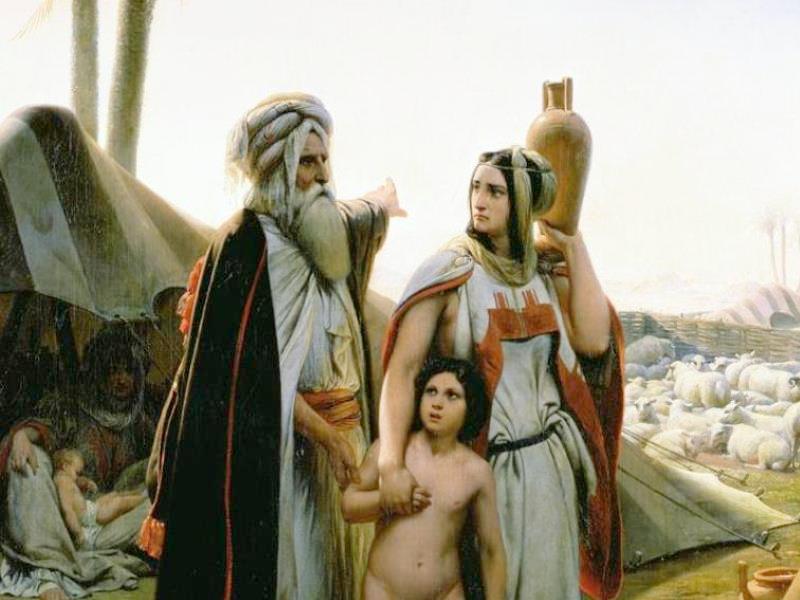
Ancient Hebrews: Old Testament Account and Historicity--Abraham

Figure 1.--Here we have a painting by Horace Vernet depicting Abraham driving out Hagar and their son Ishmael. We read this story in the book of Genesis. Abraham had no children by his wife Sarah. He had a son by the slave Hagar. The child was named Ishmael. (Genesis 16). Later also Sarah became pregnant and had a son that was named Isaac who can be seen un the background. So Sarah asked Abraham to drive out the slave and her son, because Ishmael had no to share the inheritance with the legitimate son (Genesis 21:10). Abraham gave to Hagar bread and water and drove out the woman and the child to the desert (Genesis 21:14). The text tells that, saved by an angel, Ishmael became the founder of a great people, the Ishmaelites, i.e. the Arabs. This story is also an ancient evidence of the difficult relation between Hebrews and Arabs, dating before the Muslim era. The Koran has many stories about Ishmael, but he is never described as the son of a slave. Ishmael has always the precedence over Isaac. He is the first born son of Abraham. Ishmael helped Abraham (Ibrahim) to build the Kaaba (Surah 2: 125-127). French artiat Horace Vernet (1789-1863) painted this work in 1837. The clothing depicted is largely imaginative. It is likely that younger boys like Ishmael here often went unclothed.
|
|
Abraham is geberally seen as the great patriarch and founder of the Hebrew people. It is with Abraham that God concluded the Convenent. The basic story told in Genesis is that Abraham was son of Terah (son of Nahor, son of Serug, etc. -- Genesis 11). Abraham's story is essentially the history of the establishment of the covenant between Abraham and God. This of course is the central tennant of Judaism. God called Abraham to leave his land, family and household in Mesopotamia in return for a new land, family and inheritance in Canaan. This can be interpreted as the ancient Hebrews developing their claim to Canaan (modern Palestine). As the story is mythological it can not be dated, but more interesting is just when it became oart of the Jewish tradition. It is not clear when this tennant was developed because there surely was an oral traditiin before the Torah was actually enshrined in writing. The stories in Genesis, including Abraham, cannot be related to any known history. As a result most modern biblical histories no longer begin with the patriarchal era. Whether the story conveys any insight into early migratory pattern is unknown. His first born son Ishmael was by his Egyptian maidservant/slave Hagar (Genesis 16). While Ishmael was still very young; Abraham’s wife Sarai mistreated Hagar and she fled into the wilderness. Hagar almost died. God (or an angel of God) helped her find water. Her Biblical scholars are confused. There are similar accounts in Genesis 16 while Hagar was pregnant with Ishmael and Genesis 21 after Ishmael was weaned. Later Sarah became pregnant and had a son that was named Isaac. So Sarah asked Abraham to drive out the slave and her son, because Ishmael would claim a share of the inheritance with the legitimate son (Genesis 21:10). Abraham gave Hagar bread and water and drove her and the child into the desert (Genesis 21:14). The text tells that, saved by an angel, Ishmael became the founder of a great people, the Ishmaelites-- i.e. the Arabs. This story is also an ancient evidence of the difficult relation between Hebrews and Arabs, dating before the Muslim era. The confusing Biblical text has led people to debate whether these are the same account recorded twice, or two different events. When Abraham died, Isaac and Ishmael buried him beside Isaac’s mother Sarah (Genesis 25). Ishmael had 12 sons: Nebaioth, Kedar, Adbeel, Mibsam, Mishma, Dumah, Massa, Hadad, Tema, Jedur, Naphish, and Kedemah (Genesis 25).
CIH

Navigate the Children in History Website:
[Return to the Main Ancient Hebrew history: Old Testament Account and Histrodicity ]
[Return to the Main Ancient Hebrew history]
[Return to the Main ancient civilization page]
[Introduction]
[Animals]
[Biographies]
[Chronology]
[Climatology]
[Clothing]
[Disease and Health]
[Economics]
[Geography]
[History]
[Human Nature]
[Law]
[Nationalism]
[Presidents]
[Religion]
[Royalty]
[Science]
[Social Class]
[Bibliographies]
[Contributions]
[FAQs]
[Glossaries]
[Images]
[Links]
[Registration]
[Tools]
[Children in History Home]
Created: 8:00 AM 9/30/2014
Last updated: 8:00 AM 9/30/2014



